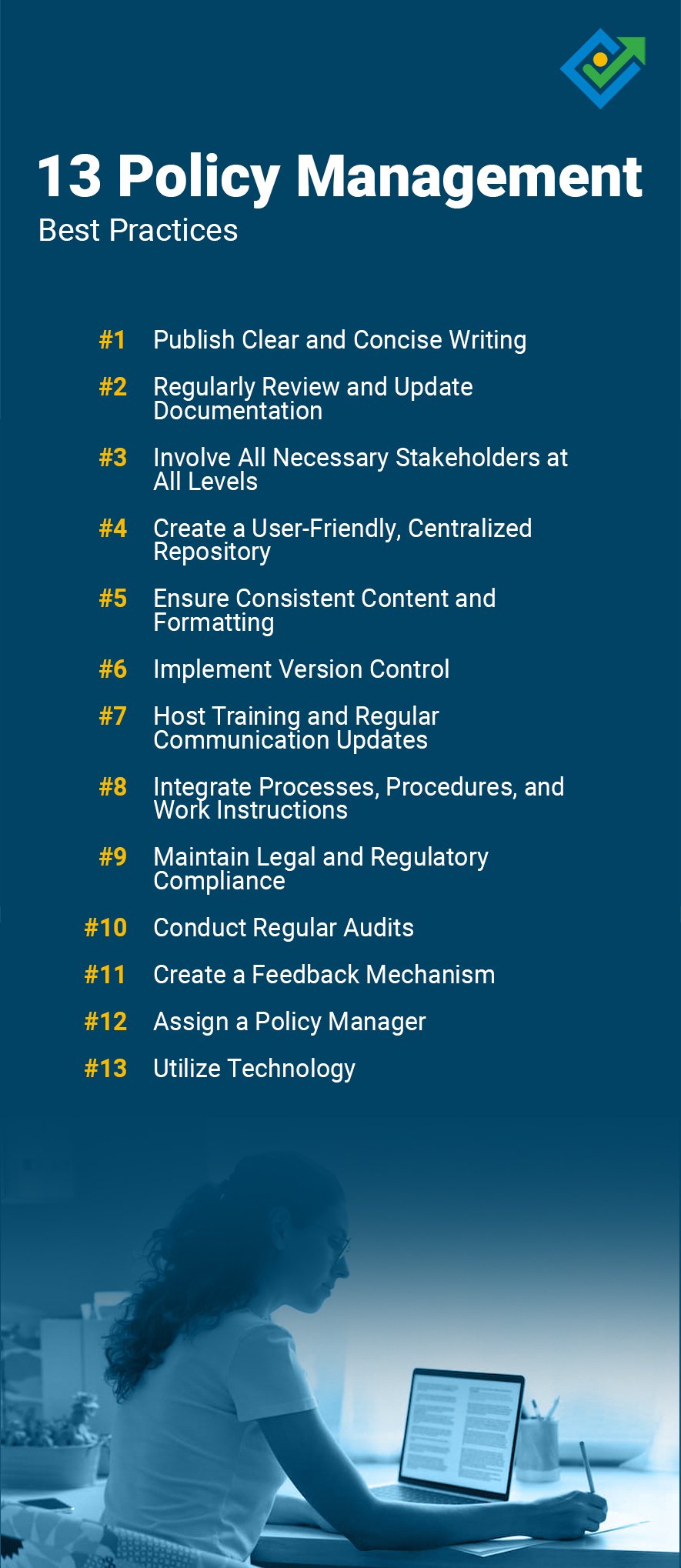
Policies are the backbone of any organization, providing guidelines and standards that shape operations, ensure compliance, and promote consistency. However, effectively managing these policies and ensuring policy management best practices presents its own set of challenges.
In this blog, we will explore tips for optimizing policy management processes, empowering organizations to maintain alignment, mitigate risks, and foster a culture of compliance. Whether you're a seasoned compliance professional or just starting to navigate the complexities of policy management, discover practical solutions for achieving policy management excellence.
What is Policy Management?
Policy management refers to the process of creating, communicating, implementing, and monitoring policies within an organization.
Policies help individuals within an organization understand how they should behave or make decisions. These organizational policies maintain consistency, promote compliance with legal and regulatory requirements, and ensure that every employee operates in a manner aligned with the organization's values and goals.
Policies do not contain steps; they are simply guidelines in which decisions are made.
5 Benefits of Policy Management
The importance of policy management is clear through the outcomes of an effective system.
- Consistency and Standardization: Policy management promotes consistency in decision-making and behavior across the organization.
- Operational Efficiency: Clear and accessible policies enable employees to understand expectations, reducing the time and resources spent on confusion, disputes, or corrections.
- Accountability and Transparency: Clearly communicated policies ensure that managers and employees are held accountable for their actions and decisions, resulting in a trustworthy and ethical work environment. Clear policies will help you avoid a situation one of our customers, a bank manager, found himself in when one of his employees said, “You didn’t tell me I couldn’t do it,” after a major mishap.
- Enhanced Compliance: Effective policy management helps prevent legal issues and regulatory violations, reducing the risk of fines, penalties, or reputational damage.
- Risk Mitigation: Well-managed policies contribute to risk mitigation by providing guidelines and controls that help identify and address potential risks.
Understand the Difference Between Policy and Procedure
Not understanding the difference between policy and procedure is common in most organizations. When people don’t understand the difference, they often write from a stream of consciousness and mix them together. This causes confusion, as well as frustrating maintenance problems. Regulators don’t like it either.
A procedure is a task. It tells someone how to perform a job.
Policies do not contain steps; they are simply guidelines in which decisions are made.
A good example everyone experiences is Vacation. The policy covers what employees are eligible to take, carryover guidelines, etc. Related procedures include how to make a vacation request, how to track employee time off, how to set out-of-office notifications, and more.
Don’t mix policies and procedures together.
The best practice is to break each policy and each procedure into its own document and LINK them together. This modular approach makes it easier to locate and update your content. It also makes it easier to track policies. For example, you can pull out and run reports like “all policies pertaining to bank operations” or “Code of Conduct policies,” for example. It’s also easier on your users because they won’t have to wade through long documents to find the answers they need. (For more helpful information, check out this related blog, "Difference Between Policy, Procedure, Work Instructions")
13 Policy Management Best Practices
With over 30 years of experience, we at Comprose have discovered the best ways to create, organize, and distribute policies within an organization. Keep reading to find out our expert tips and best practices for an effective policy management program.

1. Publish Clear and Concise Writing
Arguably the most important part of a policy is for it to be written in a way that employees understand. What’s the point of having a policy if nobody knows what it means? Express policies in clear, simple language to ensure employees understand them easily. Avoid jargon or overly complex terminology.
The biggest writing problem we see is general or vague wording that makes your policies subject to interpretation. Policies need to be crystal clear. When writing a policy:
- Cover all policy provisions
- State exceptions
- State consequences
- Use examples where applicable
- Link to any related procedures for carrying out the policy
2. Regularly Review and Update Documentation
Periodically review policies to ensure they remain current and aligned with changes in the organization. This is a step that many policy creators forget. New policies are reviewed before publishing, but after that, they tend to sit without being edited.
Thankfully, tools such as Zavanta offer automatic reminders to review documentation on a periodic basis, whether that be weekly, monthly, or yearly. These reminders help to ensure that the most up-to-date information is included in all policies from your subject matter experts.
3. Involve All Necessary Stakeholders at All Levels
Involve relevant stakeholders in the policy development process to gather perspectives and increase the chance of a successful implementation.
Stakeholders should be from all levels of your organization, from C-suite to managers to front-line workers and employees. Policies impact each person in the organization, which means all levels of employees should have a part of the policy process to ensure everyone is on the same page and policies are implemented correctly.
4. Create a User-Friendly, Centralized Repository
Maintain a centralized and easily accessible location for all policies to ensure that employees can quickly locate and reference the most up-to-date versions. This repository should also be accessible from any device, including mobile phones. Many organizations try to use existing tools for file sharing, but policy management software is likely a better solution than multi-purpose tools like SharePoint or Box.
5. Ensure Consistent Content and Formatting
Establish a consistent format and content requirements for effective policies and enforce these standards across all policy writers. Your readers and approvers will find policies easier to find, navigate, and understand.
One way to ensure that all policies in your organization look the same is to use structured content. With a structured content model, a policy always has the same information broken up into logical content chunks. The system applies a standard format, not the policy writer. This prevents everyone from doing their own thing, which is a major drawback in free-form tools like MS Word or text areas in some policy managers.
All policies contain the same information and look the same. The core of our solution, Zavanta, is structured content.
6. Implement Version Control
Implement a version control system to track policy updates and changes, ensuring that the latest version of policies are available, and that the history of modifications is documented. A version control system will decrease the likelihood of employees or individuals in different departments using outdated information and will make audits much easier by clearly outlining the updates to documentation since the previous audit.
7. Host Training and Regular Communication Updates
Develop comprehensive training programs to educate employees about policy content and establish effective communication channels to keep them informed of updates or changes. By providing training, employees can gain a clear understanding of the rationale behind policies, their importance, and how to implement them effectively.
Another option to ensure employee comprehension is implementing employee attestation, usually through an eSignature campaign. This will confirm employee acknowledgement of policy updates and offer a streamlined method for reinforcing policy changes and expectations.
8. Integrate Processes, Procedures, and Work Instructions
Ensure policies are seamlessly integrated with related processes, procedures, and work instructions to provide a comprehensive framework for decision-making and behavior.
Avoid creating policies without procedures (and vice versa).
Some organizations develop policies but then fail to create and link to related procedures. This is a big mistake. It's kind of like stating “This is our policy on...” but then relying on employees to figure out on their own how to comply. This is risky at best and can often be disastrous.
The opposite – creating procedures without related policies – is also a common error. If your work procedures aren’t captured and cross-checked with stated policies, your organization could be uncoordinated or even be noncompliant with legal, regulatory, or internal controls.
Operations Mapping™ is a proven way to define what policies and procedures you need and create the framework. Operations Mapping training teaches you how to build a process – procedure - policy system implementing best practices and intentionally designed to produce the results you need. Operations Mapping is best applied using Zavanta, our specialized software for policies and procedures, but you can use any tool you want.
9. Maintain Legal and Regulatory Compliance
Ensure risk management by encouraging your compliance team to regularly assess policies to confirm compliance with relevant laws, regulations, and industry standards. Depending on your industry or compliance program, this may need to be done on an ongoing basis. By ensuring all policies are updated according to any regulatory change and the most recent standards, you are minimizing the risk of non-compliance for the organization.
10. Conduct Regular Audits
Conduct regular audits to evaluate the effectiveness of policy implementation and identify areas for improvement or adjustments. Regular audits serve as a proactive measure to enhance policy effectiveness, make sure policy changes are made accordingly, streamline operations, and promote continuous improvement within the organization.
11. Create a Feedback Mechanism
Establish a feedback mechanism to allow employees to provide input on policy modifications they may recommend. Since employees use policies regularly, it’s important to offer the opportunity to request changes or updates to your documentation. This helps to foster a sense of inclusion and address potential concerns or ambiguities.
12. Assign a Policy Manager
Dedicate one person to be held responsible and maintain ownership for all policy management and implementation. By designating one individual you are streamlining the policy process, ensuring accountability, and minimizing the risk of confusion or oversight.
13. Utilize Technology
Leverage a policy management software solution to streamline the creation, distribution, and tracking of policies, enhancing overall efficiency and accountability in the process. Policy management tools serve to document and distribute standard operating procedures in easily understandable formats.
One example of a policy and procedure management solution is Zavanta. Zavanta is designed to streamline the process of creating, managing, and distributing policies, procedures, and other critical documentation within organizations.
Zavanta Offers an Easy Policy Management Portal
Zavanta software is your solution for comprehensive policy and procedure management.
Thoughtfully designed by industry experts, Zavanta's policy management system is purposely built to make policy management best practices easy within the system. Zavanta is an all-in-one solution that streamlines the entire life cycle of policies and procedures - from initial creation to regular updates, reviews, and implementation. With Zavanta, employees can access clear, accurate policies and procedures when they need them.
Contact us today to start a conversation.
Additional Resources




